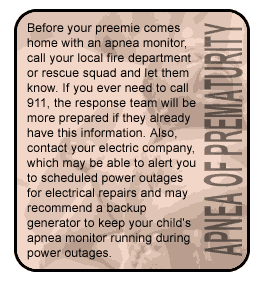 |




It's a parent's worst nightmare. What could be more terrifying than hearing or watching your baby stop breathing? With all the other complications of a preterm birth, is apnea of prematurity something else to worry about? Does it go away on its own or can it be cured? Worse yet, does this condition cause SIDS? Apnea of prematurity is fairly common in preemies and usually resolves on its own around the time the premature infant has matured enough to equal the age of a full-term infant at birth. Once apnea of prematurity stops, it does not come back. But there's no doubt about it - it's frightening while it's happening. What's the Difference Between AOP and Periodic Breathing?  Apnea is a medical term that means someone has stopped
breathing. Most experts define apnea of prematurity (AOP) as a condition
in which premature infants stop breathing for 15 to 20 seconds during sleep. Apnea is a medical term that means someone has stopped
breathing. Most experts define apnea of prematurity (AOP) as a condition
in which premature infants stop breathing for 15 to 20 seconds during sleep.
But Eric Gibson, MD, a neonatologist, says it's hard to measure and define the duration of cessation of breathing. He prefers to describe AOP as a condition in which babies (who are generally born at less than 35 weeks' gestation) have periods when they stop breathing or their heart rate drops (a slowed heart rate is known as bradycardia). These breathing abnormalities may last for up to 2 to 3 months after the birth of these premature infants, depending on the infant's gestational age at birth. Although it's normal for all infants to have pauses in breathing and heart rates, those with AOP have drops in heart rate below 80 beats per minute, which causes them to become pale or bluish. They may also appear limp, and their breathing may be noisy. They then either start breathing again by themselves or require help to resume breathing. Apnea of prematurity generally occurs after 2 days of life and up to a week of life. Spells associated with AOP may happen once a day or many times a day. The infant will be closely evaluated to make sure the apnea isn't due to another condition, such as infection or internal bleeding. The lower the infant's weight and level of prematurity at birth, the more likely he is to have AOP spells. Periodic breathing is different from AOP in that the breathing pause lasts just a few seconds. The infant's breathing pattern is characterized by a pause in breathing followed by several rapid and shallow breaths. Periodic breathing is not accompanied by a change in facial color (such as no blueness around the mouth) or a drop in heart rate. A baby who has periodic breathing resumes regular breathing on his own. Periodic breathing is common in premature newborns, and although frightening to parents, is usually harmless.

|

 |







